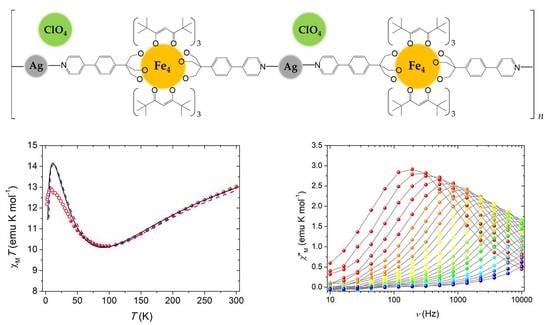New Silver(I) Coordination Polymer with Fe4 Single-Molecule Magnets as Long Spacer
Abstract
:1. Introduction
2. Results and Discussion
2.1. Synthesis of the Tripodal Ligand H3PhpPy
2.2. Assembly of Fe4 and Its Molecular Structure
2.3. Assembly of Fe4Ag
2.4. Magnetic Characterization
3. Materials and Methods
3.1. General Information
3.2. Synthesis of 2-(4-(pyridin-4-yl)phenyl)ethanol (1)
3.3. Synthesis of 2-(4-(Pyridin-4-yl)phenyl)acetaldehyde (2)
3.4. Synthesis of 2-(Hydroxymethyl)-2-(4-(pyridin-4-yl)phenyl)propane-1,3-diol (H3PhpPy)
3.5. Synthesis of [Fe4(PhpPy)2(dpm)6] (Fe4)
3.6. Synthesis of {[Fe4(PhpPy)2(dpm)6Ag](ClO4)}n (Fe4Ag)
3.7. X-ray Data Collection and Structure Determination
3.8. Magnetic Measurements
4. Conclusions
Supplementary Materials
Author Contributions
Funding
Acknowledgments
Conflicts of Interest
References
- Gatteschi, D.; Sessoli, R.; Villain, J. Molecular Nanomagnets; Oxford University Press: Oxford, UK, 2006; ISBN 978-0-19-856753-0. [Google Scholar]
- Natterer, F.D.; Yang, K.; Paul, W.; Willke, P.; Choi, T.; Greber, T.; Heinrich, A.J.; Lutz, C.P. Reading and writing single-atom magnets. Nature 2017, 543, 226–228. [Google Scholar] [CrossRef] [PubMed] [Green Version]
- Goodwin, C.A.P.; Ortu, F.; Reta, D.; Chilton, N.F.; Mills, D.P. Molecular magnetic hysteresis at 60 kelvin in dysprosocenium. Nature 2017, 548, 439–442. [Google Scholar] [CrossRef] [PubMed] [Green Version]
- Guo, F.-S.; Day, B.M.; Chen, Y.-C.; Tong, M.-L.; Mansikkamäki, A.; Layfield, R.A. A Dysprosium Metallocene Single-Molecule Magnet Functioning at the Axial Limit. Angew. Chem. Int. Ed. 2017, 56, 11445–11449. [Google Scholar] [CrossRef] [PubMed]
- Liu, K.; Zhang, X.; Meng, X.; Shi, W.; Cheng, P.; Powell, A.K. Constraining the coordination geometries of lanthanide centers and magnetic building blocks in frameworks: A new strategy for molecular nanomagnets. Chem. Soc. Rev. 2016, 45, 2423–2439. [Google Scholar] [CrossRef] [PubMed]
- Whitehead, G.F.S.; Moro, F.; Timco, G.A.; Wernsdorfer, W.; Teat, S.J.; Winpenny, R.E.P. A Ring of Rings and Other Multicomponent Assemblies of Cages. Angew. Chem. Int. Ed. 2013, 52, 9932–9935. [Google Scholar] [CrossRef] [PubMed]
- Jeon, I.-R.; Clérac, R. Controlled association of single-molecule magnets (SMMs) into coordination networks: Towards a new generation of magnetic materials. Dalton Trans. 2012, 41, 9569–9586. [Google Scholar] [CrossRef] [PubMed]
- Kostakis, G.E.; Hewitt, I.J.; Ako, A.M.; Mereacre, V.; Powell, A.K. Magnetic coordination clusters and networks: Synthesis and topological description. Philos. Trans. R. Soc. Math. Phys. Eng. Sci. 2010, 368, 1509–1536. [Google Scholar] [CrossRef] [PubMed]
- Roubeau, O.; Clérac, R. Rational Assembly of High-Spin Polynuclear Magnetic Complexes into Coordination Networks: The Case of a [Mn4] Single-Molecule Magnet Building Block. Eur. J. Inorg. Chem. 2008, 2008, 4325–4342. [Google Scholar] [CrossRef]
- Abstracts from the X INSTM National Conference on Materials Science and Technology. J. Appl. Biomater. Funct. Mater. 2016, 14, e84–e128. [CrossRef]
- Nava, A.; Rigamonti, L.; Zangrando, E.; Sessoli, R.; Wernsdorfer, W.; Cornia, A. Redox-Controlled Exchange Bias in a Supramolecular Chain of Fe4 Single-Molecule Magnets. Angew. Chem. Int. Ed. 2015, 54, 8777–8782. [Google Scholar] [CrossRef] [PubMed]
- Accorsi, S.; Barra, A.-L.; Caneschi, A.; Chastanet, G.; Cornia, A.; Fabretti, A.C.; Gatteschi, D.; Mortalò, C.; Olivieri, E.; Parenti, F.; et al. Tuning Anisotropy Barriers in a Family of Tetrairon(III) Single-Molecule Magnets with an S = 5 Ground State. J. Am. Chem. Soc. 2006, 128, 4742–4755. [Google Scholar] [CrossRef] [PubMed]
- Gregoli, L.; Danieli, C.; Barra, A.-L.; Neugebauer, P.; Pellegrino, G.; Poneti, G.; Sessoli, R.; Cornia, A. Magnetostructural Correlations in Tetrairon(III) Single-Molecule Magnets. Chem. Eur. J. 2009, 15, 6456–6467. [Google Scholar] [CrossRef] [PubMed]
- Rigamonti, L.; Cotton, C.; Nava, A.; Lang, H.; Rüffer, T.; Perfetti, M.; Sorace, L.; Barra, A.-L.; Lan, Y.; Wernsdorfer, W.; et al. Diamondoid Structure in a Metal-Organic Framework of Fe4 Single-Molecule Magnets. Chem. Eur. J. 2016, 22, 13705–13714. [Google Scholar] [CrossRef] [PubMed]
- Rigamonti, L.; Piccioli, M.; Malavolti, L.; Poggini, L.; Mannini, M.; Totti, F.; Cortigiani, B.; Magnani, A.; Sessoli, R.; Cornia, A. Enhanced Vapor-Phase Processing in Fluorinated Fe4 Single-Molecule Magnets. Inorg. Chem. 2013, 52, 5897–5905. [Google Scholar] [CrossRef] [PubMed]
- Rigamonti, L.; Piccioli, M.; Nava, A.; Malavolti, L.; Cortigiani, B.; Sessoli, R.; Cornia, A. Structure, magnetic properties and thermal sublimation of fluorinated Fe4 Single-Molecule Magnets. Polyhedron 2017, 128, 9–17. [Google Scholar] [CrossRef]
- Ninova, S.; Lanzilotto, V.; Malavolti, L.; Rigamonti, L.; Cortigiani, B.; Mannini, M.; Totti, F.; Sessoli, R. Valence electronic structure of sublimated Fe4 single-molecule magnets: An experimental and theoretical characterization. J. Mater. Chem. C 2014, 2, 9599–9608. [Google Scholar] [CrossRef]
- Mannini, M.; Pineider, F.; Danieli, C.; Totti, F.; Sorace, L.; Sainctavit, P.; Arrio, M.-A.; Otero, E.; Joly, L.; Cezar, J.C.; et al. Quantum tunnelling of the magnetization in a monolayer of oriented single-molecule magnets. Nature 2010, 468, 417–421. [Google Scholar] [CrossRef] [PubMed]
- Rodriguez-Douton, M.J.; Mannini, M.; Armelao, L.; Barra, A.-L.; Tancini, E.; Sessoli, R.; Cornia, A. One-step covalent grafting of Fe4 single-molecule magnet monolayers on gold. Chem. Commun. 2011, 47, 1467–1469. [Google Scholar] [CrossRef] [PubMed]
- Mannini, M.; Tancini, E.; Sorace, L.; Sainctavit, P.; Arrio, M.-A.; Qian, Y.; Otero, E.; Chiappe, D.; Margheriti, L.; Cezar, J.C.; et al. Spin Structure of Surface-Supported Single-Molecule Magnets from Isomorphous Replacement and X-ray Magnetic Circular Dichroism. Inorg. Chem. 2011, 50, 2911–2917. [Google Scholar] [CrossRef] [PubMed]
- Tancini, E.; Mannini, M.; Sainctavit, P.; Otero, E.; Sessoli, R.; Cornia, A. On-Surface Magnetometry: The Evaluation of Superexchange Coupling Constants in Surface-Wired Single-Molecule Magnets. Chem. Eur. J. 2013, 19, 16902–16905. [Google Scholar] [CrossRef] [PubMed]
- Westrup, K.C.M.; Boulon, M.-E.; Totaro, P.; Nunes, G.G.; Back, D.F.; Barison, A.; Jackson, M.; Paulsen, C.; Gatteschi, D.; Sorace, L.; et al. Adding Remnant Magnetization and Anisotropic Exchange to Propeller-like Single-Molecule Magnets through Chemical Design. Chem. Eur. J. 2014, 20, 13681–13691. [Google Scholar] [CrossRef] [PubMed]
- Rigamonti, L.; Cornia, A.; Nava, A.; Perfetti, M.; Boulon, M.-E.; Barra, A.-L.; Zhong, X.; Park, K.; Sessoli, R. Mapping of single-site magnetic anisotropy tensors in weakly coupled spin clusters by torque magnetometry. Phys. Chem. Chem. Phys. 2014, 16, 17220–17230. [Google Scholar] [CrossRef] [PubMed]
- Rigamonti, L.; Nava, A.; Boulon, M.-E.; Luzon, J.; Sessoli, R.; Cornia, A. Experimental and Theoretical Studies on the Magnetic Anisotropy in Lanthanide(III)-Centered Fe3Ln Propellers. Chem. Eur. J. 2015, 21, 12171–12180. [Google Scholar] [CrossRef] [PubMed]
- Burgess, J.A.J.; Malavolti, L.; Lanzilotto, V.; Mannini, M.; Yan, S.; Ninova, S.; Totti, F.; Rolf-Pissarczyk, S.; Cornia, A.; Sessoli, R.; et al. Magnetic fingerprint of individual Fe4 molecular magnets under compression by a scanning tunnelling microscope. Nat. Commun. 2015, 6, 8216. [Google Scholar] [CrossRef] [PubMed] [Green Version]
- Zu, F.; Liu, Z.; Yao, K.; Gao, G.; Fu, H.; Zhu, S.; Ni, Y.; Peng, L. Nearly Perfect Spin Filter, Spin Valve and Negative Differential Resistance Effects in a Fe4-based Single-molecule Junction. Sci. Rep. 2015, 4, 4838. [Google Scholar] [CrossRef] [PubMed]
- Batten, S.R.; Champness, N.R.; Chen, X.-M.; Garcia-Martinez, J.; Kitagawa, S.; Öhrström, L.; O’Keeffe, M.; Paik Suh, M.; Reedijk, J. Terminology of metal–organic frameworks and coordination polymers (IUPAC Recommendations 2013). Pure Appl. Chem. 2013, 85, 1715–1724. [Google Scholar] [CrossRef] [Green Version]
- Vukotic, V.N.; Loeb, S.J. One-, Two- and Three-Periodic Metal-Organic Rotaxane Frameworks (MORFs): Linking Cationic Transition-Metal Nodes with an Anionic Rotaxane Ligand. Chem. Eur. J. 2010, 16, 13630–13637. [Google Scholar] [CrossRef] [PubMed]
- Condorelli, G.G.; Motta, A.; Pellegrino, G.; Cornia, A.; Gorini, L.; Fragalà, I.L.; Sangregorio, C.; Sorace, L. Site-Specific Anchoring of Tetrairon(III) Single Molecule Magnets on Functionalized Si(100) Surfaces. Chem. Mater. 2008, 20, 2405–2411. [Google Scholar] [CrossRef]
- Viguier, R.; Serratrice, G.; Dupraz, A.; Dupuy, C. New Polypodal Polycarboxylic Ligands—Complexation of Rare-Earth Ions in Aqueous Solution. Eur. J. Inorg. Chem. 2001, 1789–1795. [Google Scholar] [CrossRef]
- Beaufort, L.; Delaude, L.; Noels, A.F. A new tripodal ligand system based on the iminophosphorane functional group. Part 1: Synthesis and characterization. Tetrahedron 2007, 63, 7003–7008. [Google Scholar] [CrossRef]
- Barra, A.L.; Caneschi, A.; Cornia, A.; Fabrizi de Biani, F.; Gatteschi, D.; Sangregorio, C.; Sessoli, R.; Sorace, L. Single-Molecule Magnet Behavior of a Tetranuclear Iron(III) Complex. The Origin of Slow Magnetic Relaxation in Iron(III) Clusters. J. Am. Chem. Soc. 1999, 121, 5302–5310. [Google Scholar] [CrossRef]
- Wu, C.-H.S.; Rossman, G.R.; Gray, H.B.; Hammond, G.S.; Schugar, H.J. Chelates of β-diketones. VI. Synthesis and characterization of dimeric dialkoxo-bridged iron(III) complexes with acetylacetone and 2,2,6,6-tetramethylheptane-3,5-dione (HDPM). Inorg. Chem. 1972, 11, 990–994. [Google Scholar] [CrossRef]
- Rigamonti, L.; Rusconi, M.; Forni, A.; Pasini, A. The role of the atomic charges on the ligands and platinum(II) in affecting the cis and trans influences in [PtXL(PPh3)2]+ complexes (X = NO3, Cl, Br, I.; L = 4-substituted pyridines, amines, PPh3). A 31P NMR and DFT investigation. Dalton Trans. 2011, 40, 10162. [Google Scholar] [CrossRef] [PubMed]
- Nakamoto, K. Infrared and Raman Spectra of Inorganic and Coordination Compounds, 6th ed.; Wiley: Hoboken, NJ, USA, 2009; ISBN 978-0-471-74339-2. [Google Scholar]
- Geddes, A.L.; Bottger, G.L. Infrared spectra of silver-ammine complexes. Inorg. Chem. 1969, 8, 802–807. [Google Scholar] [CrossRef]
- Kondo, J.; Tada, Y.; Dairaku, T.; Saneyoshi, H.; Okamoto, I.; Tanaka, Y.; Ono, A. High-Resolution Crystal Structure of a Silver(I)-RNA Hybrid Duplex Containing Watson-Crick-like C-Silver(I)-C Metallo-Base Pairs. Angew. Chem. Int. Ed. 2015, 54, 13323–13326. [Google Scholar] [CrossRef] [PubMed]
- Kim, J.G.; Cho, Y.; Lee, H.; Lee, Y.-A.; Jung, O.-S. o-, m-, and p-Pyridyl isomer effects on construction of 1D loop-and-chains: Silver(I) coordination polymers with Y-type tridentate ligands. J. Mol. Struct. 2016, 1122, 186–191. [Google Scholar] [CrossRef]
- Zhu, H.-L.; Zhang, M.; Sun, Z.-Y.; Rong, N.-N.; Zhang, B.; Li, Y.; Fun, H.-K. Crystal structure of di(4-aminopyridine)silver(I) trifluoromethylsulfate, Ag(C5H6N2)2(CF3SO3). Z. Für Krist. New Cryst. Struct. 2003, 218, 521–522. [Google Scholar] [CrossRef]
- Liu, J.-T.; Ng, S.W. catena-Poly[[silver-μ-piperazine-κ2N:N′]perchlorate]. Acta Crystallogr. Sect. E Struct. Rep. Online 2006, 62, m1992–m1993. [Google Scholar] [CrossRef]
- Cong, F.-D.; Yu, F.-Y.; Wei, Z.; Ng, S.W. Bis(2-methyl-1H-imidazole-κN3)silver(I) nitrate dihydrate. Acta Crystallogr. Sect. E Struct. Rep. Online 2009, 65, m1535. [Google Scholar] [CrossRef] [PubMed]
- Massoud, A.A.; Gohar, Y.M.; Langer, V.; Lincoln, P.; Svensson, F.R.; Jänis, J.; Gårdebjer, S.T.; Haukka, M.; Jonsson, F.; Aneheim, E.; et al. Bis 4,5-diazafluoren-9-one silver(I) nitrate: Synthesis, X-ray structures, solution chemistry, hydrogel loading, DNA coupling and anti-bacterial screening. New J. Chem. 2011, 35, 640–648. [Google Scholar] [CrossRef]
- Shimokawa, C.; Itoh, S. The First β-Diketiminate−Ag(I) Complexes. Macrocyclic Dinuclear and Tetranuclear Ag(I)-Complexes and Linear Coordination Polymer Ag(I)-Complex. Inorg. Chem. 2005, 44, 3010–3012. [Google Scholar] [CrossRef] [PubMed]
- Chilton, N.F.; Anderson, R.P.; Turner, L.D.; Soncini, A.; Murray, K.S. PHI: A powerful new program for the analysis of anisotropic monomeric and exchange-coupled polynuclear d- and f-block complexes. J. Comput. Chem. 2013, 34, 1164–1175. [Google Scholar] [CrossRef] [PubMed]
- Cole, K.S.; Cole, R.H. Dispersion and Absorption in Dielectrics I. Alternating Current Characteristics. J. Chem. Phys. 1941, 9, 341–351. [Google Scholar] [CrossRef]
- Dekker, C.; Arts, A.F.M.; de Wijn, H.W.; van Duyneveldt, A.J.; Mydosh, J.A. Activated dynamics in a two-dimensional Ising spin glass: Rb2Cu1−xCoxF4. Phys. Rev. B 1989, 40, 11243–11251. [Google Scholar] [CrossRef]
- Lunghi, A.; Totti, F.; Sessoli, R.; Sanvito, S. The role of anharmonic phonons in under-barrier spin relaxation of single molecule magnets. Nat. Commun. 2017, 8, 14620. [Google Scholar] [CrossRef] [PubMed]
- Bruker. SMART, SAINT and SADABS; Bruker AXS Inc.: Madison, WI, USA, 1997. [Google Scholar]
- Sheldrick, G.M. Crystal structure refinement with SHELXL. Acta Crystallogr. Sect. C Struct. Chem. 2015, 71, 3–8. [Google Scholar] [CrossRef] [PubMed]
- Farrugia, L.J. WinGX and ORTEP for Windows: An update. J. Appl. Crystallogr. 2012, 45, 849–854. [Google Scholar] [CrossRef]
- Burnett, M.N.; Johnson, C.K. ORTEP-III: Oak Ridge Thermal Ellipsoid Plot Program for Crystal Structure Illustrations; U.S. Department of Energy Office of Scientific and Technical Information: Oak Ridge, TN, USA, 1996.
- Bain, G.A.; Berry, J.F. Diamagnetic Corrections and Pascal’s Constants. J. Chem. Educ. 2008, 85, 532–536. [Google Scholar] [CrossRef]
- Rigamonti, L.; Bridonneau, N.; Poneti, G.; Tesi, L.; Sorace, L.; Pinkowicz, D.; Jover, J.; Ruiz, E.; Sessoli, R.; Cornia, A. A Pseudo-Octahedral Cobalt(II) Complex with bis-Pyrazolylpyridine Ligands Acting as a Zero-Field Single-Molecule Magnet with Easy Axis Anisotropy. Chem. Eur. J. 2018, 24, 8857–8868. [Google Scholar] [CrossRef] [PubMed]
- Fox, B.S.; Beyer, M.K.; Bondybey, V.E. Coordination Chemistry of Silver Cations. J. Am. Chem. Soc. 2002, 124, 13613–13623. [Google Scholar] [CrossRef] [PubMed]
- Shoeib, T.; El Aribi, H.; Siu, K.W.M.; Hopkinson, A.C. A Study of Silver(I) Ion−Organonitrile Complexes: Ion Structures, Binding Energies, and Substituent Effects. J. Phys. Chem. A 2001, 105, 710–719. [Google Scholar] [CrossRef]
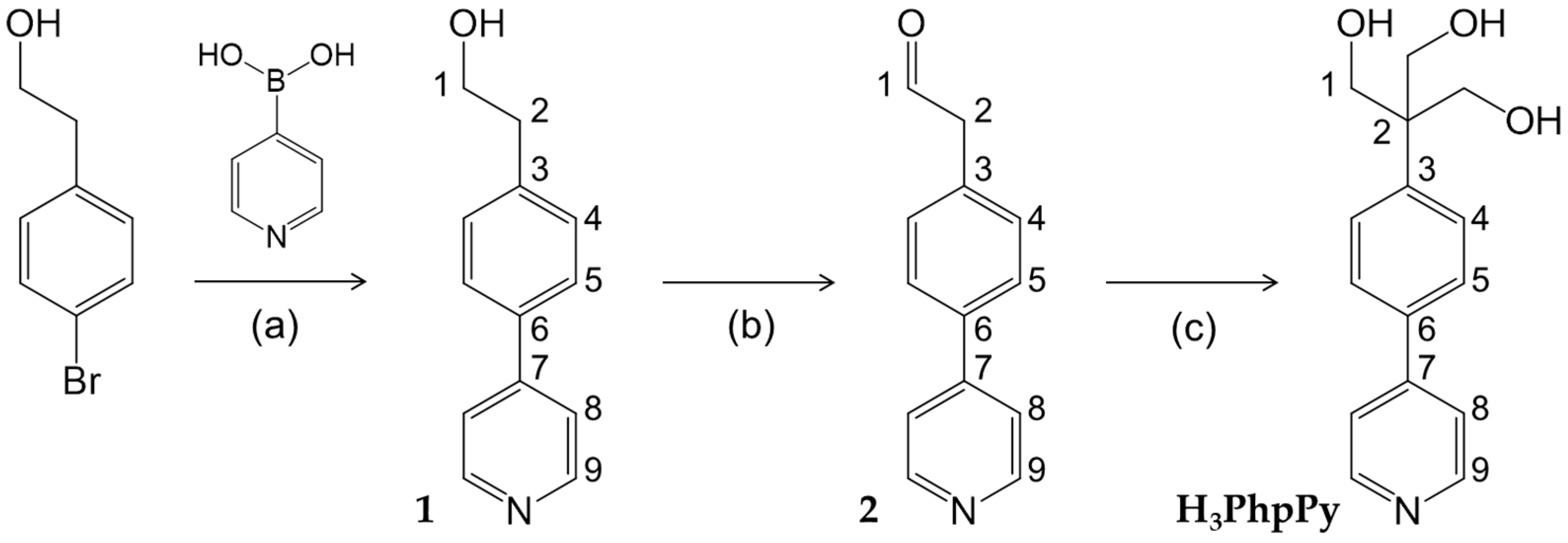
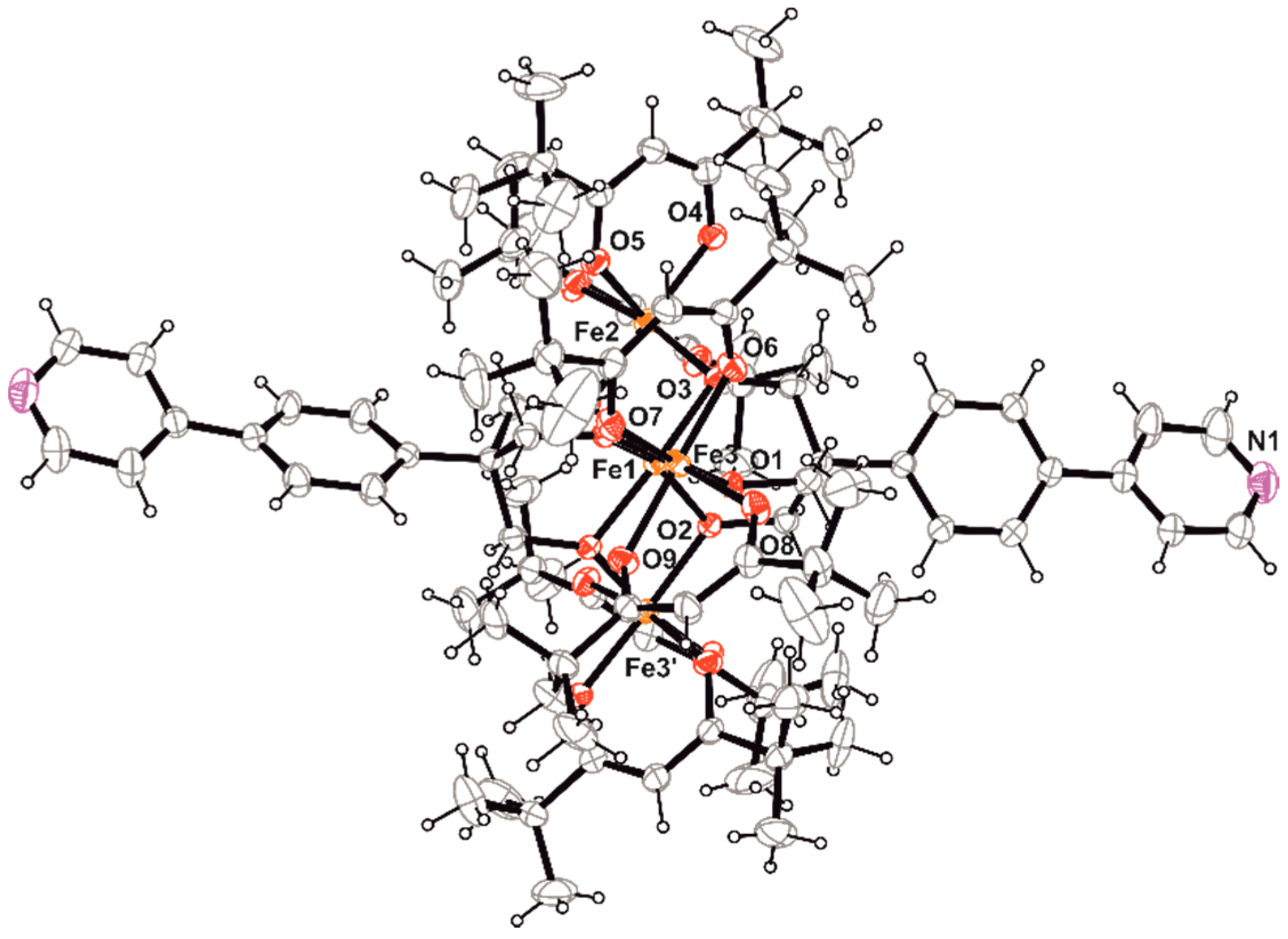

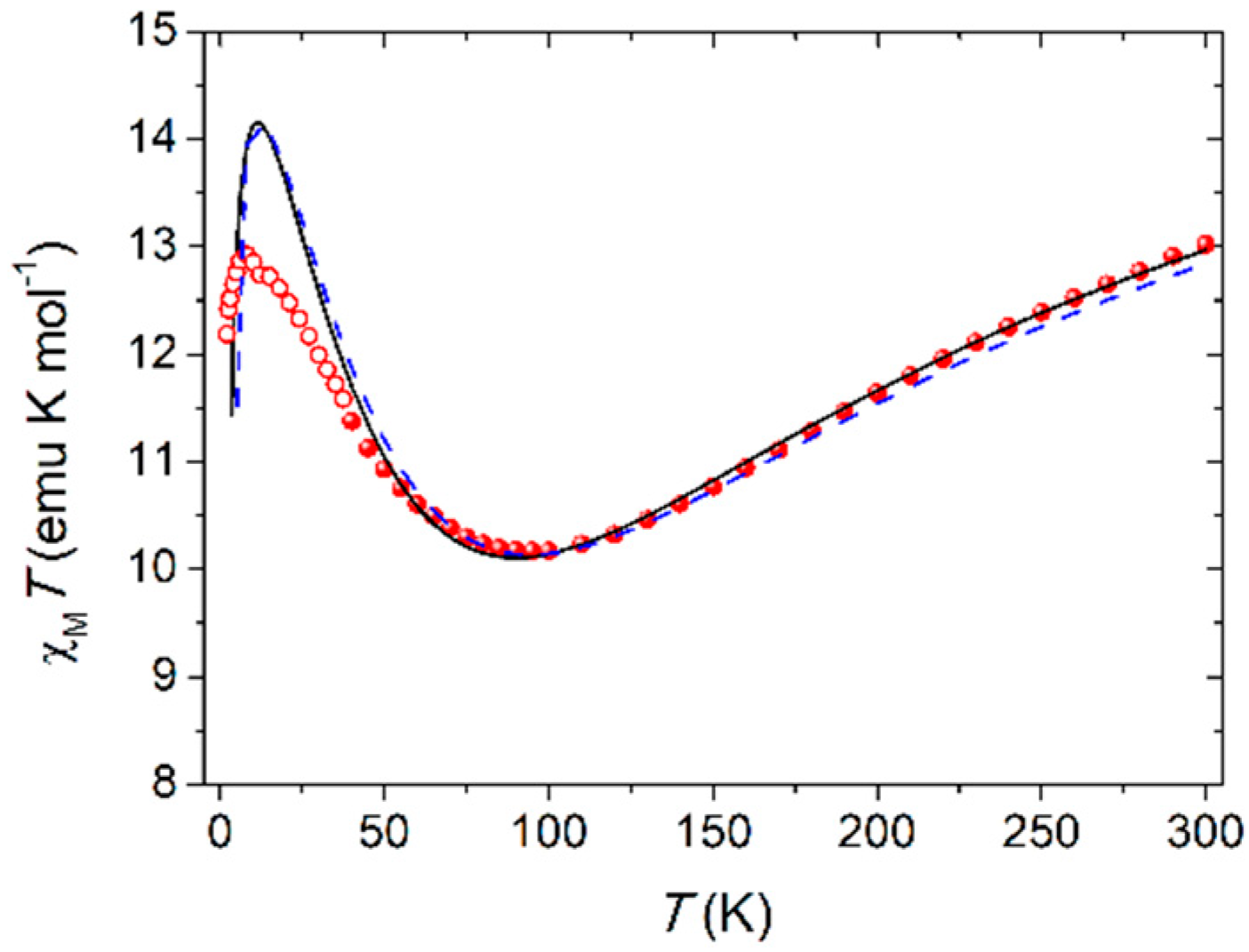
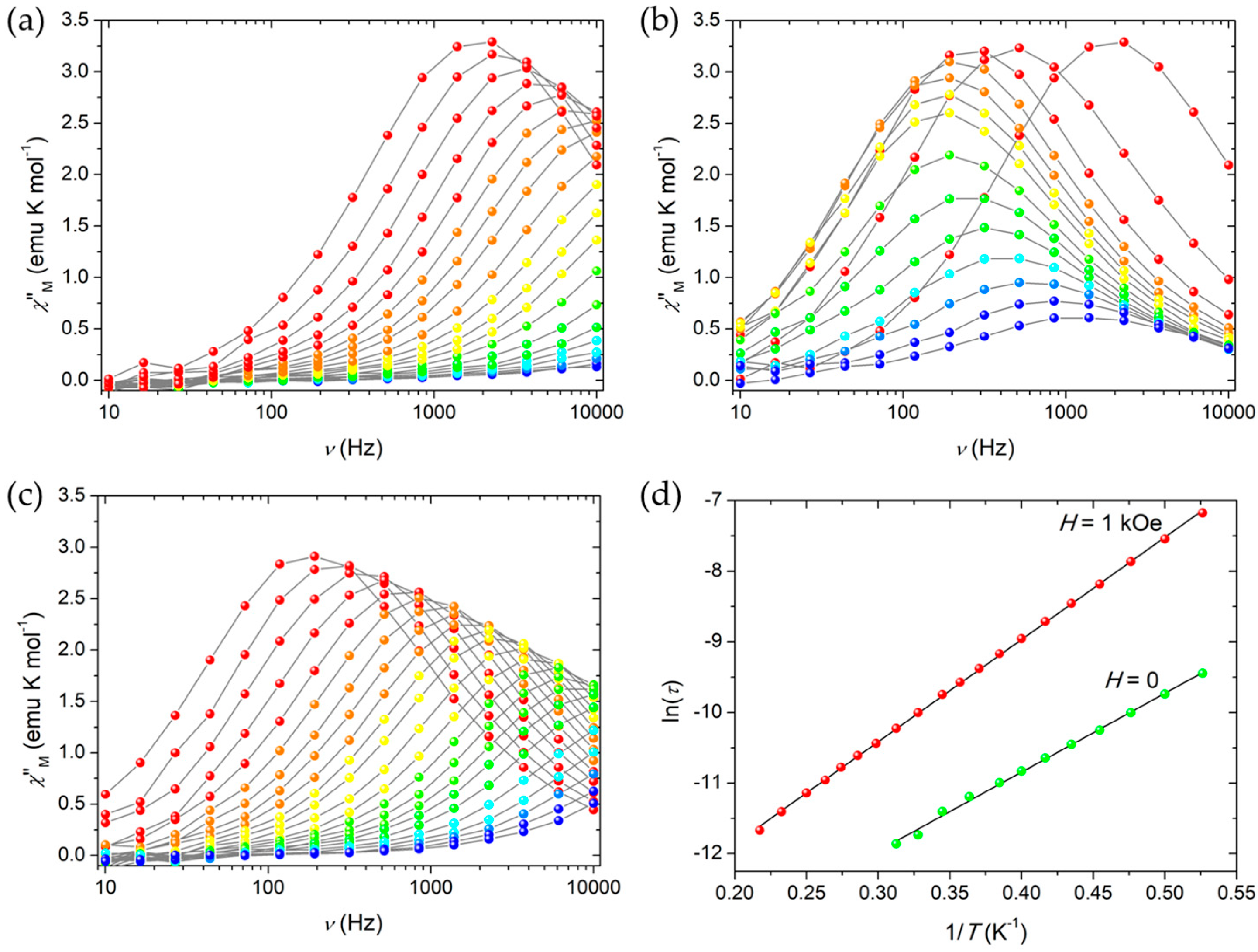
| Parameter | Value | Parameter | Value | Parameter | Value |
|---|---|---|---|---|---|
| Fe1–O1 | 1.994(3) | Fe2–O4 | 1.988(3) | Fe1⋅⋅⋅Fe2 | 3.0926(12) |
| Fe1–O2 | 1.971(2) | Fe2–O5 | 2.029(3) | Fe1⋅⋅⋅Fe3 | 3.0700(8) |
| Fe1–O3 | 1.978(2) | Fe3–O6 | 1.994(3) | Fe2⋅⋅⋅Fe3 | 5.3903(11) |
| Fe2–O3 | 1.977(2) | Fe3–O7 | 1.997(3) | Fe3⋅⋅⋅Fe3’ | 5.2063(15) |
| Fe3–O1 | 1.972(2) | Fe3–O8 | 1.998(3) | Fe2⋅⋅⋅Fe1⋅⋅⋅Fe3 | 122.014(17) |
| Fe3–O2 | 1.989(3) | Fe3–O9 | 2.005(3) | Fe3⋅⋅⋅Fe1⋅⋅⋅Fe3’ | 115.970(18) |
| Fe1–O1–Fe3 | 101.46(11) | Fe1–O2–Fe3 | 101.66(11) | Fe1–O3–Fe2 | 102.87(12) |
| γ (Fe2) 2 | 67.16(10) | γ (Fe3) 3 | 69.08(8) | N1⋅⋅⋅N1’ | 23.413(11) |
© 2018 by the authors. Licensee MDPI, Basel, Switzerland. This article is an open access article distributed under the terms and conditions of the Creative Commons Attribution (CC BY) license (http://creativecommons.org/licenses/by/4.0/).
Share and Cite
Rigamonti, L.; Vaccari, M.; Roncaglia, F.; Baschieri, C.; Forni, A. New Silver(I) Coordination Polymer with Fe4 Single-Molecule Magnets as Long Spacer. Magnetochemistry 2018, 4, 43. https://doi.org/10.3390/magnetochemistry4040043
Rigamonti L, Vaccari M, Roncaglia F, Baschieri C, Forni A. New Silver(I) Coordination Polymer with Fe4 Single-Molecule Magnets as Long Spacer. Magnetochemistry. 2018; 4(4):43. https://doi.org/10.3390/magnetochemistry4040043
Chicago/Turabian StyleRigamonti, Luca, Manuela Vaccari, Fabrizio Roncaglia, Carlo Baschieri, and Alessandra Forni. 2018. "New Silver(I) Coordination Polymer with Fe4 Single-Molecule Magnets as Long Spacer" Magnetochemistry 4, no. 4: 43. https://doi.org/10.3390/magnetochemistry4040043




